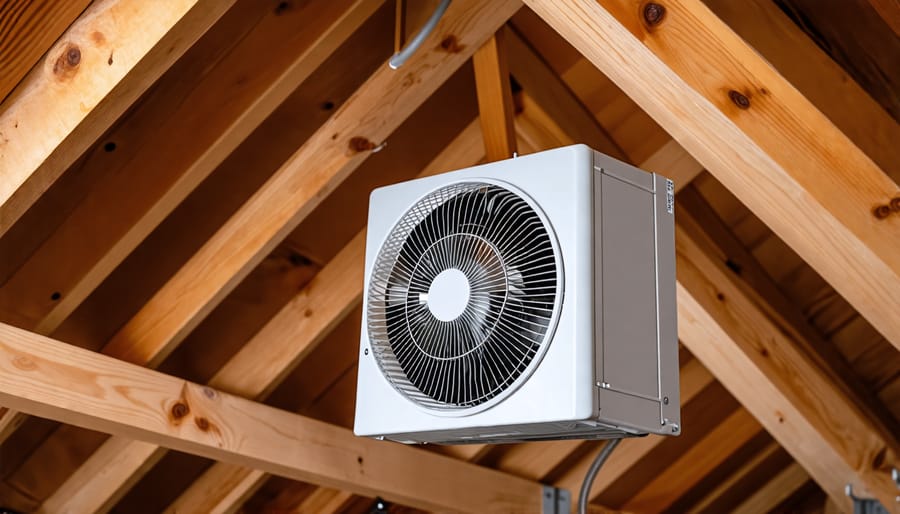Determine the required attic fan size by:
- Calculate attic square footage by multiplying attic length and width
- Aim for 10-15 air changes per hour for proper ventilation
- Divide attic volume (sq ft x height) by desired air changes to get minimum CFM
- Choose a fan rated for at least that CFM, sized for your attic’s square footage

Factors Affecting Attic Fan Size
Attic Square Footage
To determine the appropriate attic fan size, start by measuring your attic’s square footage. Grab a tape measure and calculate the length and width of your attic space. Multiply these two numbers to get the total square footage. For example, if your attic is 30 feet long and 20 feet wide, your attic is 600 square feet.
Keep in mind that your attic’s shape may not be a perfect rectangle. In this case, break the space into smaller, more manageable sections. Measure each section individually and add up their square footages to get the total.
The attic’s square footage plays a crucial role in selecting the right fan size. A general rule of thumb is to have 1 CFM (cubic feet per minute) of ventilation per square foot of attic space. So, for a 600 square foot attic, you’d need a fan rated for at least 600 CFM. However, other factors like climate, roof pitch, and insulation also impact fan sizing, so it’s essential to consider these as well when making your final decision.
Roof Pitch and Attic Volume
The roof pitch and attic volume are crucial factors in determining the appropriate size for your attic fan. A steeper roof pitch means more attic space to ventilate, requiring a larger fan. To calculate your attic’s volume, measure the length, width, and height from the floor to the peak. Multiply these three numbers together to get the cubic footage. For example, an attic measuring 40 feet long, 30 feet wide, and 8 feet high would have a volume of 9,600 cubic feet (40 x 30 x 8). Once you know your attic’s volume, consult the manufacturer’s guidelines for the recommended fan size based on cubic feet per minute (CFM) ratings. A general rule of thumb is to have at least 0.7 CFM per square foot of attic space, but this may vary depending on factors like climate and roof design.
Climate and Temperature
The local climate and average summer temperatures significantly impact the sizing requirements for your attic fan. In hotter regions with intense, prolonged heat waves, a larger and more powerful attic fan is essential to effectively remove the trapped hot air. Conversely, in milder climates with moderate summers, a smaller fan may suffice. Consider the number of cooling degree days in your area, which measure how often and intensely temperatures rise above 65°F (18°C). More cooling degree days indicate a greater need for robust attic ventilation. Consult local weather data and HVAC professionals to determine the optimal attic fan size for your climate.
Insulation and Ventilation
Proper attic insulation and ventilation play a crucial role in determining the right size attic fan for your home. Well-insulated attics retain less heat, reducing the workload on your fan. Assess your insulation’s R-value and ensure it meets recommended levels for your climate. Existing ventilation, such as ridge vents and soffit vents, also impacts fan sizing. These passive vents help exhaust hot air and promote natural airflow, supplementing your fan’s cooling effects. If your attic lacks adequate insulation or ventilation, address these issues before installing a fan for optimal efficiency and home comfort.
Sizing Calculations and Guidelines
CFM Requirements per Square Foot
To determine the right attic fan size, a general rule of thumb is to aim for about 0.7 CFM per square foot of attic space. This means that for every square foot of attic area, you’ll want a fan capable of moving 0.7 cubic feet of air per minute. For example, if your attic is 1,000 square feet, you’ll need an attic fan rated at around 700 CFM (1,000 x 0.7).
However, this is just a baseline recommendation. The exact CFM requirements may vary depending on factors like your local climate, roof pitch, and the amount of attic insulation. In hotter regions or homes with steeper roofs, a slightly higher CFM per square foot (up to 1 CFM) may be beneficial for optimal cooling. Conversely, in milder climates or well-insulated attics, a lower CFM rating (around 0.5 per square foot) might suffice.
Sizing Example Scenarios
Let’s walk through a few example attic fan sizing scenarios. First, consider a 1,200 square foot attic in a mild climate. Using the general rule of 1 CFM per square foot, you would need a fan rated for around 1,200 CFM. A 1,600 CFM fan would provide a bit of extra ventilation power for good measure.
Now, let’s look at a larger 2,000 square foot attic in a hot, humid region. In this case, you’ll want more airflow to effectively remove the heat and moisture. Aim for at least 1,800-2,000 CFM, but a 2,400 CFM fan would be even better equipped to handle the job.
What about a smaller 800 square foot attic in an area with moderate summers? An 800-1,000 CFM fan should suffice here. However, if the attic has a steep roof pitch or limited soffit vents, sizing up to 1,200 CFM would help compensate for the reduced natural ventilation.
Finally, consider a 1,500 square foot attic with a complex roof design featuring multiple valleys and hips. These features can impede airflow, so you’ll want to lean towards the higher end of the sizing range. A fan in the 1,800-2,000 CFM range would be a solid choice to ensure adequate ventilation throughout the various roof sections.
Remember, these are general guidelines. For the most accurate sizing, consult with a professional who can assess your attic’s unique characteristics and recommend the optimal fan size and configuration for your needs. With the right fan in place, you’ll be on your way to a cooler, drier attic and a more comfortable home overall.

Additional Considerations
Energy Efficiency and Ratings
When shopping for an attic fan, look for models with high energy efficiency ratings. The most common rating is CFM/watt, which measures how much airflow (in cubic feet per minute) the fan moves per watt of power consumed. A higher CFM/watt rating indicates better efficiency. ENERGY STAR certified fans meet strict efficiency guidelines and can help you save on energy costs. While more efficient fans may have a higher upfront price, they can pay for themselves over time through reduced electricity bills. Opting for an energy-efficient attic fan is a smart choice for both your wallet and the environment.

Noise Levels
When selecting an attic fan, noise levels are an important consideration for homeowner comfort. While a powerful fan may effectively cool your attic, a loud motor can be disruptive, especially if the fan is located near bedrooms or living areas. Look for fans with low dB (decibel) ratings, typically below 50 dB, which is comparable to a quiet conversation. Some fans feature insulated housings or vibration-dampening mounts to minimize noise transfer. Reading customer reviews can provide insights into real-world noise experiences. Balancing adequate airflow with acceptable noise levels will ensure your attic fan provides efficient cooling without compromising your home’s tranquility.
Professional Installation vs. DIY
When deciding whether to install an attic fan yourself or hire a professional, consider your skill level, time, and budget. DIY installation can save money but requires electrical and roofing knowledge, proper tools, and significant time. Improper installation may lead to leaks, damage, or inefficient operation. Professional installation ensures the job is done correctly and safely but comes at a higher cost. If you’re handy and confident in your abilities, DIY could be a rewarding option. However, if you’re unsure or value peace of mind, professional installation might be the way to go. Ultimately, the decision depends on your specific situation and comfort level with home improvement projects.
Conclusion
Choosing the right size attic fan is essential for effectively cooling and ventilating your home. By considering factors such as attic square footage, roof pitch, climate, and the presence of existing vents, you can determine the optimal CFM rating for your needs. As a general rule, aim for 1 CFM per square foot of attic space, with adjustments based on your specific circumstances. Proper sizing ensures that your attic fan efficiently removes hot air, reduces cooling costs, and prevents moisture buildup. Investing in the right size attic fan not only enhances comfort but also protects your home’s structure and integrity. With the knowledge gained from this article, you can confidently select an attic fan that delivers optimal performance for years to come.
